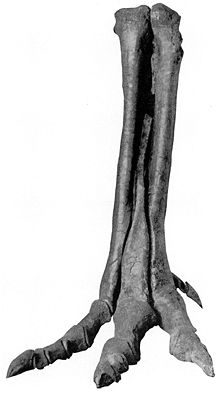Alectrosaurus
| Alectrosaurus Temporal range: Late Cretaceous,
| |
|---|---|

| |
| Scientific classification | |
| Kingdom: | |
| Phylum: | |
| Class: | |
| Superorder: | |
| Order: | |
| Suborder: | |
| Superfamily: | |
| Genus: | Alectrosaurus Gilmore, 1933
|
| Species | |
Alectrosaurus (Template:Pron-en; meaning "unmarried lizard") is a genus of tyrannosauroid theropod dinosaur from the Late Cretaceous Period of Inner Mongolia. It was a bipedal carnivore with a body shape similar to its much larger relative, Tyrannosaurus rex. Alectrosaurus was much smaller though, most likely less than five meters (17 ft) long.
The generic name Alectrosaurus can also be translated as "alone lizard," and is derived from the Greek words alektros ("unmarried") and sauros ("lizard"). At the time of its discovery, it was unlike any other Asian carnivore known. There is one named species (A. olseni), which is named in honor of George Olsen, who discovered the first specimens in 1923 on the third American Museum of Natural History expedition to Mongolia. Both genus and species were named by American paleontologist Charles Gilmore in 1933.
History of discovery

The holotype (AMNH 6554), or original specimen, of Alectrosaurus was a hind limb discovered in the Iren Dabasu Formation of the Inner Mongolia Autonomous Region (Nei Mongol Zizhiqu) of the People's Republic of China.[1] Forelimb material in the type specimen was later found to be misidentified therizinosauroid remains.[2] The age of this geologic formation is not clear, but is commonly cited as the Campanian stage of the Late Cretaceous Period, about 83 to 74 million years ago.
More material, including comparable hind limb material as well as skull and shoulder elements, has been referred to Alectrosaurus. These fossils were found in the Bayan Shireh Formation of Outer Mongolia, a formation which is also of uncertain age.[3] It may possibly extend into the early Campanian, but recent estimates suggest it was deposited from Cenomanian through Santonian times.[4] Iren Dabasu and Bayan Shireh dinosaur faunas are similar, but van Itterbeecka et al. claimed that the Iren Dabasu is probably Campanian-Maastrichtian in age and possibly correlated with the Nemegt Formation, so it is not surprising that a species of Alectrosaurus would be found there.[5]
Furthermore, several more partial skeletons may have been found in both Inner and Outer Mongolia.[6] These remain undescribed as of early 2007.
Taxonomy
Alectrosaurus is undoubtedly a tyrannosauroid, but due to its fragmentary nature, there is presently very little confidence in restoring its relationships with other tyrannosauroids and many recent cladistic analyses have omitted it altogether. One study recovered Alectrosaurus at no less than eight equally parsimonious positions in a tyrannosauroid cladogram.[7] Some paleontologists have considered Alectrosaurus olseni to be a species of Albertosaurus.[8]
Alectrosaurus was originally characterized as a long-armed theropod, but this was due to the mistaken association of segnosaur forelimb elements.[3][9] The remaining material represents the hind limb of a true tyrannosauroid, although characterized by the low ratio between the length of its tibia and femur, meaning that both bones are about the same size, as opposed to most other tyrannosauroids, where the tibia is usually longer. The hind foot (and ankle) are also closer in size to the tibia than most tyrannosauroids, where the foot is usually longer.
The Bayan Shireh material may or may not belong to this genus, and needs further study. One cladistic analysis showed that the two sets of specimens group together exclusive of any other taxa, so they are probably at least closely related, if not the same species.[2]
References
- ^ Gilmore, C.W. (1933). On the dinosaurian fauna of the Iren Dabasu Formation. Bulletin of the American Museum of Natural History 67:23-78.
- ^ a b Holtz, T.R. (2001). The phylogeny and taxonomy of the Tyrannosauridae. In: Tanke, D.H., and Carpenter, K. (Eds.). Mesozoic Vertebrate Life. Indiana University Press:Bloomington, 64-83. ISBN 0-253-33907-3.
- ^ a b Perle, A. (1977). [On the first finding of Alectrosaurus (Tyrannosauridae, Theropoda) in the Late Cretaceous of Mongolia.] Problemy Geologii Mongolii 3:104-113. [In Russian]
- ^ Hicks, J.F., Brinkman, D.L., Nichols, D.J., and Watabe, M. (1999). Paleomagnetic and palynological analyses of Albian to Santonian strata at Bayn Shireh, Burkhant, and Khuren Dukh, eastern Gobi Desert, Mongolia. Cretaceous Research 20(6): 829-850.
- ^ van Itterbeecka, J., Horne, D.J., Bultynck, P., and Vandenbergh, N. (2005). Stratigraphy and palaeoenvironment of the dinosaur-bearing Upper Cretaceous Iren Dabasu Formation, Inner Mongolia, People's Republic of China. Cretaceous Research 26:699-725.
- ^ Currie, P.J. (2001). Theropods from the Cretaceous of Mongolia. In: Benton, M.J., Shishkin, M.A., Unwin, D.M., and Kurochkin, E.N. (Eds.). The Age of Dinosaurs in Russia and Mongolia. Cambridge University Press:Cambridge, 434-455. ISBN 052154582X.
- ^ Holtz, T.R. (2004). Tyrannosauroidea. In: Weishampel, D.A., Dodson, P., and Osmólska, H. (Eds.). The Dinosauria (2nd Edition). University of California Press:Berkeley, 111-136. ISBN 0-520-24209-2.
- ^ "Albertosaurus." In: Dodson, Peter & Britt, Brooks & Carpenter, Kenneth & Forster, Catherine A. & Gillette, David D. & Norell, Mark A. & Olshevsky, George & Parrish, J. Michael & Weishampel, David B. The Age of Dinosaurs. Publications International, LTD. p. 106-107. ISBN 0-7853-0443-6.
- ^ Mader, B.J., and Bradley, R.L. (1989). A redescription and revised diagnosis of the syntypes of the Mongolian tyrannosaur Alectrosaurus olseni. Journal of Vertebrate Paleontology 9(1):41-55.
